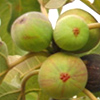Ficus carica (Fig) originates from the mountains of Asia Minor, Persia, Iraq and Turkey. It is a deciduous domesticated tree, with crooked branches, which reaches a height of 2-6 meters. Its crown is broad and its branches are pale gray. The trunk is low and has a gray, almost smooth, bark.
The fig has thick, large, broad, rough leaves that are pilose in their lower side and are emarginated into 3-5 lobes, digitated like a hand. When the leaves and stems are injured, a very bitter, sticky and milky resin pours out of them.
The syconium is the inflorescence of the fig. The syconium has a unique structure: the receptacle of the inflorescence is concave, urceolate and hollow, and carries the flowers on its inner surface. The mouth of the syconium is closed by imbricate scales that isolate the cavity of the syconium from the external world.
The small flowers that are hidden within the syconium, are isolated from the outer world. This condition is unique to species of the genus Ficus, to which the fig belongs. Pollination of the flowers is performed by tiny wasps. In some of the trees of this species the style of the female flowers inside the syconium are short. The female wasp lays her eggs in them and the wasps develop inside the female flowers. The syconium and the wasps develop concomitantly. The time until ripening of the syconium is compatible with the duration of the wasps’ development. When the mature wasps hatch from the flowers inside the syconium they make their way out, and at the same time carry pollen of the male flowers that are concentrated near the opening at the head of the syconium. This tree thus contributes pollen and is therefore called a “male tree”. The female wasp enters a young syconium of another tree, on which the fruits will develop, and is therefore called a “female tree”, where its flowers are ready for fertilization and it brings the pollen from the male flowers of the syconium in which it grew. The styles of the syconia of “female trees” are longer. The female wasps therefore do not succeed in laying their eggs in them and wasps do not develop in them. However, the flowers in these syconia are pollinated by the wasps and the syconium ripens into a fig fruit which contains seeds. Owners of fig plantations usually propagate mainly female trees, but make sure to bring syconia from male trees to the plantation at the appropriate stage, so that they will release the pollen-carrying wasps.
This mechanism of pollination of the flowers inside syconia by wasps is characteristic of all the plants of this genus. See, for example, the description of pollination in Ficus sycomorus (False sycamore). Each Ficus species has special species of wasps that causes the ripening of its fruits. The ornamental trees of the genus Ficus also require the activity of wasps, so that their fruits will ripen. The wasps that pollinate the Sacred Fig (Ficus religiosa) have been found in Israel for a long time, and it therefore yields numerous ripe fruits. However, the fruits of Ficus microcarpa trees did not ripen in Israel for a long time, because there were no wasps that could cause this process. Only in the 1970s did wasps arrive in Israel that since then cause the ripening of the syconia of trees of this species. These wasps include a species that pollinates the flowers in the syconium and causes the production of fertile seeds, and another species that lays its eggs inside the syconium without pollinating the flowers and without causing the production of seeds. This wasp is considered a parasite of the symbiotic relation between the tree and the wasp that pollinates it.
The fig begins to yield fruit after 4 years, and harvesting is prolonged because the fruits do not all ripen at once. The fruits of the fig do not have a long shelf-life, and are therefore preserved by drying, i.e. dried figs which during antiquity served as a basic food.
Today many fig trees grow alongside ancient springs, water holes and neglected orchards. Their fruits are sweet and edible.
Written by Amram Eshel







